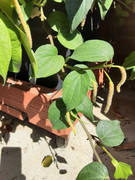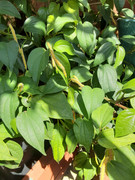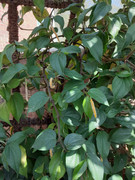10
« on: July 09, 2017, 03:25:03 PM »
In fact, it was a double-whammy.
My house caught fire February 5, 2016. After the fire department put out the fire, I was able to rescue a few dozen plants from the freezing weather; mostly coffee tree sprouts. My wife and I moved into my Mom's condo...in Gatlinburg, TN...
...Where we got burned out again in the wildfires on November 28, 2016. This time I lost every plant except a tiny cutting of vanilla orchid which I happened to take with me when we left for Thanksgiving.
(As an aside, if you don't KNOW you have "Replacement of Contents" coverage, call your insurance agent ASAP and get it. We had it, and they even paid on my tropical plants!)
I'm trying to remain positive, which is why I'm looking at this as an opportunity to grow some different things in addition to replacing the plants that did well in the old sunroom. The good news is my new house has a larger sunroom with a higher ceiling than the old house did. While we were able to salvage and reuse much of the old plate glass, it is now being used in a more efficient way. In the old house, a foot and a half of the glass was overhang and was thus wasted for light transmission. Now almost the whole pane is open to the sky.
Barring further delays (delays are likely because of the massive amount of reconstruction in the county--contractors are swamped) we should be able to move back in within a month.
I'm not asking for pity, but I certainly would appreciate suggestions for sources of replacement plants as well as recommendations for new plant varieties to try. Everything must be suitable for containers because without the shades, the south-facing sunroom turns into an oven in the summer. With the shades, the sunroom is too dark for plants. Plus, I like to roll everything outside so it can enjoy the humidity, natural sun and rain. (I mount my huge and large pots on casters.)
1) Coffee. My Hawaiian seed vendor has moved to Georgia and was unable to suggest an alternative. I would like to buy a hundred or so Kona Typica seeds from a very recent harvest, still in parchment and not too dry. Right now there's still time to get them to sprout, but past experience has shown that August is too late. I'd love to find some Jamaica Blue Mountain seeds or plants, but I'm not holding my breath. By the way, my previous coffee trees were surprisingly productive, and I was able to process, roast, grind, and brew some of the best coffee I ever tasted from my own plants. It will be 4-5 years before I'll be able to do that again, but I'm REALLY looking forward to that day.
2) Banana. Due to the old ceiling height, the only variety I was able to grow to flower and fruit was Super Dwarf Cavendish. I'm pretty sure I want another SDC because of previous success, but I could now also grow something a bit taller. Can you suggest a particularly tasty banana that is under, say, 10 feet/3 meters tall? Does anyone endorse Dwarf Jamaican Red?
3) Allspice. I had to top my allspice tree each year to get it to fit through the old door. That could be why it only flowered once. The new doors are 8 feet high. It would be so cool to get some allspice berries. Allspice is native to Jamaica.
4) Jamaica Cherry. I think I'd like to try this one for the first time. Are there any opinions to the contrary?
5) June Plum. This one was recommended in a previous thread as good for container gardening. June Plum was introduced into Jamaica in 1782. (Anyone sensing a theme here?) Are there any particularly sweet varieties?
6) Mango. I never had room for a mango before, but I had been considering a Pickering if some space ever opened up. Space has opened up.
7) Papaya. I had grown a TR Hovey, but it didn't fruit nearly as much as I had hoped--and the plant looked nothing like the pictures! Try that one again or something else? Maybe I didn't fertilize it enough.
8 ) Citrus. I had a Meyer lemon, a Key lime, and a Satsuma orange. All three produced well when fertilized properly, but tended to get scale over the winter.
9) Acerola. I seem to recall having varieties named Florida Sweet and Manoa Sweet. I have a sweet tooth, so the more sugar and less acid, the better.
10) Olive. I think I had an Arbequina. I've read olives must be cured, or pickled, or something before they are edible, but my wife and I love olives in marinara sauce on spaghetti. If not Arbequina, what do you recommend?
11) Surinam cherry. Are there any particularly sweet varieties?
12) Other spices: I'd love to try cloves and nutmeg again. Unfortunately, they are both incredibly tender and even moderate temperatures will kill them. Hopefully I will have better climate control in the new sunroom. I'll monitor the temperatures over the winter and decide next year.
Please feel free to suggest any other tasty tropical or sub-tropical fruit.
Thanks!
Andy







